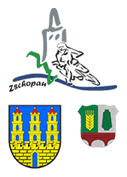Zschopau's historical town centre is characterized by its precious streets, especially within the areas of Ludwig-Würkert-Straße, Lange Straße and the market square. The extraordinary density of town houses, which are part of the cultural heritage, derive from the 2nd half of the 18th century.
At the beginning of the 20th century, high quality shops in the style of historicism were built. The most remarkable buildings are:
The Old Town Hall
The building which is now known as the Old Town Hall, has been erected in a renaissance style in 1495. The last signifying changes to the building were made in 1920, after it had been remodelled for several times before. Then, the council hall as well as the gates to the town hall and the "Ratskeller" (lit. council cellar, a typical name for a restaurant located in the basement of a town or city hall) were established. The chime of bells can be found in the tower on top of the building and was donated by Jörgen Skafte Rasmussen who also founded the local motorcycle factory. The tunes of the brazen bells can be listened to daily at 9:00 am, 1:00 pm and 6:00 pm, and additionally at 2:15 pm on Thursdays.
The New Town Hall
The New Town Hall is an impressive building situated at the front of the western part of the market square. Two remarkable stairways lead to a beautiful portal made of stone. Due to its renaissance style, it indicates that the building has been erected as a noble house in 1561. Because most parts of the building burnt down, the current architecture of the New Town Hall is characterized by a baroque style since it was reconstructed in 1751.
The "Wilke House"
The so-called "Wilke House", a marvellous half-timbered building, is located at the beginning of Johannisstraße and is retained in its original construction since it survived the fire of 1748. The copy of a post mile stone from 1727 can be found in the immediate neighbourhood.
The industrialisation commenced in Zschopau in the 19th century with the development of a spinning mill by Johann Jacob Bodemeer. Contemporary signs of these times can be found by walking along Spinnereistaße, at the complex Bodemer House, the "Kutscherhaus" (lit. coachman's house) and its barn.




